Game marketers face considerable challenges in today’s game marketing ecosystem. Not only is the games industry more competitive than ever, but the marketing space faces challenges with data efficacy, user tracking, and increasing costs with less return on investment (ROI). In such a climate, effective growth marketing can be the deciding factor between success and failure.
Luckily, you’re note alone! Get your bearings and build a successful growth marketing strategy with the information in this article. And if you’d like help, you can always reach out to us.
What is growth marketing?
Growth marketing is an approach to marketing that focuses on the ever-changing wants and needs of your gamers – with a goal toward acquisition, engagement, and retention. It uses ongoing experimentation to build content that is uniquely aligned with your players – optimizing growth through multiple channels along the way.
Ultimately, growth marketing is data-focused and geared toward driving better outcomes for your gaming business. It utilizes research to understand your target gamers, marketing channels and creatives to connect with them, data analysis to understand the impact of those channels and creatives, and iteration to improve their efficacy.
How does growth marketing differ from growth hacking?
Growth hacking can be considered a tool of growth marketing, but growth hacks are standalone actions (e.g. riding a TikTok trend to acquire players) as opposed to a comprehensive process and strategy for player growth. Growth hacks as a part of a growth marketing strategy are subject to experimentation and analysis to ensure they are optimized for your user acquisition.
Key components of a growth marketing strategy
A good growth marketing strategy essentially follows the scientific method, wherein you ask a question, form a hypothesis, carry out tests, analyze the results, and implement the data-driven solution.

- Develop high-level strategic business goals.
- Build a robust and scalable infrastructure to enable rapid analysis and testing.
- Establish clear growth goals, profitability targets, and KPIs.
- Operationalize scaled marketing efforts.
Developing strategic business objectives
Growth marketing is predominant about understanding what your key factors of success are for the business – and turning those objectives into scalable and profitable marketing channels. For most gaming businesses, this will be growing their player base, increasing revenue, and increasing the lifetime value (LTV) of players.
Understanding the player / customer lifecycle
The customer lifecycle is a fundamental concept in growth marketing that describes the stages a customer goes through from initial awareness of a brand or product to becoming a loyal, repeat customer. In the case of a games business, this would be your players. It typically consists of stages like awareness, consideration, purchase, retention, and advocacy.
Understanding this lifecycle is crucial for growth marketing because it allows businesses to tailor their strategies to meet the unique needs and expectations of customers at each stage. The ultimate goal of a games growth marketer is to extend your player’s lifecycle – increasing their lifetime value (LTV) by keeping them engaged and satisfied over the long term, turning them into advocates who not only make repeat in-game purchases or regularly view in-game ads but also promote your games to others.
To extend the player lifecycle and increase LTV, gaming companies should focus on nurturing the post-install relationship with their players. This includes offering personalized recommendations and tips, providing exceptional customer support, and encouraging loyalty through loyalty programs or exclusive offers.
Consistent communication through email marketing, social media engagement, and relevant content can also play a crucial role in keeping players engaged. By delivering value beyond the initial install and continuously exceeding player expectations, gaming businesses can foster long-term relationships that translate into higher player lifetime value. Moreover, leveraging data analytics and gamer insights can help identify opportunities for cross-selling or upselling, further maximizing the value of each player throughout their lifecycle.
Ultimately, understanding and effectively managing this player lifecycle is key to achieving sustainable growth and building a loyal player base.
Carrying out agile data analysis
Agile data analysis is a critical component of growth marketing, focusing on the rapid and iterative process of collecting, processing, and analyzing data to inform marketing strategies and decisions. Its purpose in growth marketing is to enable marketers to adapt quickly to changing trends and customer behaviors, make data-driven decisions, and optimize marketing campaigns in real-time.
Unlike traditional, rigid data analysis approaches, agile data analysis emphasizes flexibility and responsiveness, allowing marketers to stay nimble and adjust their strategies based on evolving insights. This approach is particularly valuable in the fast-paced world of digital marketing, where consumer preferences, market dynamics, and technology are constantly evolving.
Effectively carrying out agile data analysis as a game marketer begins with setting clear objectives and key performance indicators (KPIs) to measure the success of marketing initiatives. Game marketers collect data from various sources, such as website analytics, social media metrics, player feedback, and sales data, and employ tools and technologies to process and analyze this information in real-time.
The key is to conduct regular and ongoing analysis to identify trends, detect opportunities, and pinpoint areas for improvement. By regularly assessing the performance of marketing campaigns, gaming businesses can adapt quickly, allocate resources more effectively, and optimize their strategies for maximum growth.
Agile data analysis also encourages a culture of experimentation, where marketing teams continually test new ideas and concepts to refine their approach and enhance player engagement, ultimately leading to improved ROI and sustained growth.
Take a smart approach to multi-channel marketing
Multi-channel marketing is a strategic approach that involves using multiple marketing channels to reach and engage with a target audience. Its primary purpose is to increase a brand’s visibility, expand its reach, and ultimately drive growth by being present where customers are, in various online and offline spaces.
The goal of multi-channel marketing in gaming is to create a seamless and consistent player experience across your company’s channels, ensuring that gamers can interact with your brand through their preferred platforms – whether it’s social media, email, websites, app store landing pages, or inside your games. This approach acknowledges that gamers today have diverse preferences and behaviors and, to maximize growth, businesses must adapt by delivering a unified and cohesive brand message across all touchpoints.
Effectively carrying out multi-channel marketing in the games space involves several key steps. First, businesses need to identify the most relevant and influential channels for their specific target audience. This involves market research and understanding player behavior. Next, they should develop a cohesive and consistent brand message and content strategy that can be adapted for each channel while maintaining a unified brand identity.
Implementing marketing automation tools can help streamline the process, allowing for personalized messaging and tracking of gamer interactions. Regular analysis of performance metrics is crucial to fine-tune the strategy and make data-driven decisions.
By successfully executing multi-channel marketing, gaming companies can boost brand recognition, engage with players in meaningful ways, and optimize their growth potential by catering to diverse gamer preferences.
Perform A/B testing
A/B testing is a fundamental technique in growth marketing that helps businesses systematically compare two or more versions of a marketing asset or strategy to determine which one yields better results.
The primary purpose of A/B testing is to optimize various aspects of marketing campaigns, such as email subject lines, website design, ad copy, or call-to-action buttons, to improve performance metrics like click-through rates, conversion rates, and ultimately, revenue.
For game marketers, the overarching goal is to make data-driven decisions, ensuring that marketing efforts are as effective and efficient as possible, leading to higher player engagement, increased conversion rates, and improved ROI.
To conduct an A/B test, a game marketer typically starts by selecting a specific element or variable to test. This could be anything from the color of a button on a website to the wording of a marketing email.
A control group (Group A) is used to represent the current version or the original element, while one or more variants (Group B, C, etc.) feature the proposed changes or alternatives. The test subjects, which could be website visitors, email recipients, social media users, or in-game players, are randomly assigned to these groups.
Data is collected on how each group interacts with the different versions, and the results are statistically analyzed to determine which variant performs better. Marketers can then use the insights gained from the A/B test to make informed decisions, refine their marketing strategies, and continually optimize their campaigns for better results.
Review customer feedback (player feedback)
Customer feedback plays a pivotal role in growth marketing, serving as a valuable source of insights for businesses looking to enhance their products or services, improve customer experiences, and drive growth. For game developers and publishers, your players are your customers.
The primary purpose of collecting player feedback is to gain a deeper understanding of their preferences, pain points, and expectations. It offers gaming businesses a direct line to their audience, enabling them to tailor their offerings to better meet player needs and expectations.
To solicit player feedback, game marketers can employ various methods, such as surveys, online reviews, feedback forms, social media engagement, or player interviews. These strategies help in capturing a wide range of opinions and perspectives, providing a more comprehensive view of gamer sentiment.
Analyzing player feedback is a crucial step in the process. Feedback can be both qualitative and quantitative, and businesses must categorize, segment, and assess the data to identify trends and patterns.
By utilizing sentiment analysis tools, natural language processing, and other analytics techniques, businesses can gain actionable insights from the feedback. Once this data is interpreted, it can be used to drive growth. Businesses can implement changes, updates, or new strategies based on the feedback, leading to improved game mechanics and engagement with players.
By addressing player concerns and aligning offerings with their desires, companies can enhance player satisfaction and loyalty and, ultimately, drive growth through increased player retention, word-of-mouth referrals, and enhanced brand reputation.
In this way, player feedback becomes an invaluable asset in the arsenal of games growth marketing, fostering a continuous cycle of improvement and expansion.
Build data-driven creatives
Data-driven content is a powerful strategy in growth marketing that relies on the analysis of data and insights to create content that is tailored to the specific needs, preferences, and behaviors of the target audience. Its primary purpose is to enhance the effectiveness of marketing efforts by delivering content that resonates with customers, captures their attention, and drives engagement and conversions.
In gaming, the customer is your player. Data-driven content leverages data from various sources, including in-game analytics, player feedback, social media metrics, and market research, to craft content that addresses pain points, answers questions, and provides solutions for your players. This approach ensures that content is not only relevant but also highly valuable to the audience, ultimately leading to increased player satisfaction, loyalty, and growth.
Creating effective data-driven content begins with collecting and analyzing relevant data to gain a deep understanding of the audience. Game marketers should use this data to identify gamer preferences, interests, and trending topics. Next, content should be customized to align with these insights, ensuring that it speaks directly to their audience’s needs.
Content formats can vary widely, from blog posts and videos to infographics or live streams. Continuous testing and iteration are essential to refine content strategies and ensure that they are meeting the desired objectives.
By aligning content with data-driven insights, game businesses can build stronger connections with gamers, improve brand reputation, and drive growth through enhanced engagement, conversion rates, and player loyalty.
Growth marketing best practices
As mentioned earlier, a good growth marketing strategy is aligned with the scientific method. Here is a closer look at the process, so you can build effective best practices.

Ask a question
To conduct a test, you first need to have a question and a hypothesis in mind. A good question should be simple – allowing for easy testing of a single variable. For example: “Does the color of my logo impact installs?”
Construct a hypothesis
Building off of your initial question, a good hypothesis sets the stage for your experiment. Therefore, it, too, should focus on one variable. For example: “A red logo will lead to more installs than our current blue logo.”
Structure a test
Your hypothesis has laid the foundation for your test. Since you will typically be testing a single variable, an A/B test, mentioned in the section above, will generally be your go-to testing format – though you may also use multivariable testing. For example: To find out if a red logo leads to more installs than a blue logo, do a split test where half of your audience sees the red logo and half sees the blue logo – making sure to track installs from each segment. A good rule of thumb is to test in short bursts, with a large number of individuals, so that you can gather meaningful data quickly – and analyze and iterate on the results.
Analyze and report
Once you have an adequate amount of data from your test, you can analyze it and build a final report of actionable insights that answers the initial question and hypothesis. Perhaps the data you collected will show that a red logo does lead to more installs than a blue logo. Perhaps it will show that the blue logo works better. Perhaps it will show that the difference between the two is negligible. Regardless, you now have the data to make an informed decision and implement any changes necessary.
Refine and implement
Once you’ve studied the results of your experiment and found the path forward, all that’s left to do is implement the change indicated in your results. In the example we’ve been using throughout this section, if the data showed a red logo worked better, you would work with your development team to implement the red version of your logo across the channel(s) it was shown to work effectively on. Just remember, this isn’t the end of your testing and experimentation. At this point, you should start the process over with another question and variable.
Good growth marketing
Remember that good growth marketing is trackable, testable, and scalable. You should have your channels connected to analytics platforms so you can see how your users are behaving in each stage of their journey. Likewise, you should be able to test out different variables in each stage of the user journey so that they can be optimized for growth. Finally, you should be able to implement and scale data-driven solutions.
Necessary skills for game marketers
While growth marketing strategies can take your game studio far, they won’t do much if they aren’t being executed by someone with a solid skillset that’s geared toward growth. To that end, a good growth marketer should have the following skills in their toolbelt.

Solution-focused
Being a solution-focused individual involves approaching challenges and opportunities with a proactive mindset that prioritizes finding practical solutions. It means constantly seeking ways to improve and achieve marketing goals by identifying and addressing obstacles, rather than dwelling on problems or limitations.
Solution-focused individuals are adept at recognizing the unique needs and preferences of their target audience, and they tailor their strategies accordingly. They embrace a data-driven approach, regularly analyzing metrics and feedback to make informed decisions. Additionally, they value creativity and innovation, experimenting with new ideas and techniques to adapt to evolving market trends and consumer behavior.
This skill is essential in growth marketing because it enables professionals to adapt to the ever-changing landscape of digital marketing, seize new opportunities, and drive results. It fosters a dynamic and agile approach, allowing marketers to overcome obstacles and achieve their objectives effectively.
Data analysis
Data analysis is the systematic process of inspecting, cleaning, transforming, and interpreting raw data to extract valuable insights, trends, and patterns. Data analysis plays a pivotal role in making informed decisions and optimizing marketing strategies.
Game marketers collect a wide range of data, including player behavior, app store landing page traffic, install rates, and social media engagement, among others. A good games growth marketer understands the company’s information pipeline and can use data analysis to take raw data and uncover valuable information about customer preferences, identify which marketing channels are most effective, and understand the impact of various campaigns on key performance indicators.
Data analysis also allows marketers to segment their audience, personalize their messaging, and continually refine their approach based on real-time feedback.
Visual design
Visual design is the art of creating and arranging visual elements to communicate a message, evoke emotions, and enhance the aesthetics of a product or content. It encompasses the use of graphics, images, typography, color schemes, and layout to craft visually appealing and engaging marketing materials and reports.
Effective visual design helps convey the brand’s identity, captivate the audience, and facilitate communication by making complex information more understandable and memorable. It plays a vital role in building a strong and consistent brand presence across various marketing channels, from websites and social media to advertisements and email campaigns.
A good growth marketer can also use visual design to make complex data understandable to teammates and colleagues in company reports – and show how the data supports strategic decisions.
Product management
Product management involves overseeing the entire lifecycle of a product, from its conception to development, launch, and beyond. It includes defining the product’s vision, gathering and analyzing market requirements, prioritizing features, coordinating with cross-functional teams such as developers, designers, and marketers, and ensuring the product aligns with customer needs and business goals.
For game marketers, product management is vital as it provides a cohesive understanding of the game’s objectives, target audience, and core features. It involves collaborating closely with product managers to comprehend the game’s roadmap, key functionalities, and the overall player experience.
By having a clear grasp of the product roadmap and its evolution, game marketers can tailor their strategies, messaging, and promotional efforts effectively to resonate with the audience and drive engagement.
Experimentalism
Experimentalism refers to the practice of continuously testing new strategies, ideas, and approaches to understand what resonates best with a target audience. It involves a mindset of exploration and iteration, where marketers embrace a willingness to try unconventional methods, analyze their impact, and adapt based on the results obtained.
For game marketers, experimentalism is crucial in an ever-evolving industry where player preferences, technology, and trends constantly change. Embracing experimentation fosters innovation and agility, allowing marketers to stay ahead by discovering new, more effective ways to reach and captivate their audience.
Critical thinking
Critical thinking is the ability to analyze, evaluate, and interpret information or situations in a logical and systematic manner. It involves examining evidence, considering multiple perspectives, and making reasoned judgments or decisions based on sound reasoning.
For game marketers, critical thinking is essential as it enables them to navigate the complex landscape of the gaming industry. It allows them to assess market trends, player behavior, and competitive landscapes objectively, enabling them to make informed decisions about marketing strategies, campaign approaches, and gamer targeting.
Multi-disciplinary marketing
Multi-disciplinary marketing involves integrating insights, strategies, and approaches from various fields or disciplines within the marketing spectrum. It encompasses leveraging expertise from diverse areas such as psychology, data analytics, design, technology, content creation, and consumer behavior to create comprehensive and effective marketing campaigns.
For game marketers, this approach is crucial as it allows them to draw from a range of disciplines to craft strategies that resonate deeply with gamers. By amalgamating insights from psychology to understand player motivations, data analytics to decipher trends and player behavior, design principles for captivating visuals, and technology for innovative marketing tools, multi-disciplinary marketing creates a holistic approach that resonates with diverse gaming audiences.
Goals and KPIs for game marketers
The overall goal for a game marketer is to grow a game’s revenue. This is done via a combination of user acquisition, retention, and conversion – as well as building the game and its developer / publisher into a recognizable brand.

Goal: Game store page traffic
One of the lowest hanging fruits for a game marketer is increasing traffic to a game’s app store landing page. We say “low hanging” because it’s one of the easier tasks for a game marketer to do.
For organic user acquisition, effective use of SEO and ASO will be required. Typical KPIs to look at include keyword rankings, chart rankings, user impressions, and user traffic. For paid user acquisition, there should be a big focus on ROAS (return on ad spend) as well.
Goal: Improve game store conversion (drive increased game installs)
Getting a potential player onto your game’s website or app store landing page is just half the battle. The other half is getting them to download the game. This will also require effective use of ASO – particularly in regard to A/B testing elements of your app store landing page to increase conversions. The main KPI you will be watching here are downloads or installs.
However, a “conversion” can also refer to gamers buying in-app purchases or clicking on in-game ads. For this, you’ll want to get a close look at player behavior and work closely with your game’s dev team to build mechanics and offers that gamers will happily click on. A good KPI to keep an eye on for this is ARPU (average revenue per user).
Goal: Increase player retention
Just kidding about half the battle being acquisition and half the battle being conversion! There’s actually another part of that battle: Retention. Retention improves player LTV (lifetime value) – which is a critical KPI you’ll be looking at to gauge the success of retention initiatives.
To improve retention, you should make sure to pay close attention to player behavior and feedback and work with your game’s development team to implement new features and requested fixes. Additionally, work with other stakeholders to build out live events you can feature – which will keep gamers coming back again and again.
Goal: Build a brand
While pursuing the above goals, there should be a constant focus on building your game’s brand as well – and, in many cases, building the brand of the developer and/or publisher.
Before you start any marketing, you and other stakeholders (marketing team, dev team, company executives) should discuss and decide on branding guidelines – logo treatment, color schemes, and brand personality (friendly, professional, sarcastic, silly, etc.).
These will be the foundation for all the other marketing that you do. KPIs for branding are opaque, but it’s good to pay attention to how receptive people are to the brand you’re putting forth – if it comes off abrasive or disingenuous, changes may be needed.
Examples of growth marketing campaigns
Growth marketing encompasses many different types of campaigns and initiatives. Here are some examples of growth marketing campaigns and initiatives to increase user acquisition and retention for higher quality gamers.

Paid advertising
Paid advertising encompasses paid social ads, in-game rewarded / video ads, and search ads on app stores like Android’s Google Play and Apple’s App Store – and their primary purpose is user acquisition. While all these channels are worth experimenting with and utilizing, some are likely to be more effective than others.
Paid social ads are best used at the top of the funnel to cast a wide net. Still, it’s important to make use of segmentation so that your ads are hitting the most relevant users possible.
Search ads are tied to keywords (search queries). If you have done proper keyword research, these ads will show up to more relevant players who are looking for games like yours.
Rewarded ads and video ads run through SDK networks and are featured in other games. These typically have the highest chance of conversion, because you are already targeting an engaged gamer and, in the case of rewarded ads, they get an in-game reward for viewing or clicking on your ad as well.
Loyalty programs
Loyalty programs are a great way to build an enduring relationship with your players. They can even act as a cross-promotional tool for all the games in a company’s portfolio. A good rewards program is likely to be split into tiers with rewards based on how active a player is in-game. This can be measured through achievements, sessions, time in-game, and other metrics. Rewards often include in-game currency or items, with the rewards increasing for each tier.
With the rise of web3 and interoperability, loyalty measurement and rewards can potentially span multiple games. One enticing loyalty program strategy would be to allow users to not only receive rewards based on in-game achievements, but also include rewards based on the number of your company’s games they play in a month – with those rewards being able to be used across your company’s games portfolio.
The key to a good loyalty program is that at least the first tier is semi-easily attainable, the program is easy to understand, the rewards are worthwhile, and the program is easy to opt in and out of.
Referral programs
Referral programs are another great way to get more people playing your game – while also building loyalty with those who already do. In truth, though, there are really two different types of referral programs.
The first is player-based: One player can invite their friends to join them in playing the game. This often nets the player with some sort of in-game reward for each player that accepts their offer, while often also giving the invitee some sort of starting bonus.
The second is influencer-based: An influencer is given a unique URL or code to share with their audience while hyping your game. For every individual who downloads the game with the URL / code, the influencer gets a payout. Often, as an extra incentive, the influencer’s audience is able to get the game at a discount through the URL / code.
Regardless of which type is being utilized, it’s important that the referral program is easy to access and share, easy to understand for all involved, and easy to track.
Top-of-funnel engagement
Top-of-funnel engagement is how the majority of people will come to learn about your game. This type of engagement is heavily focused around content marketing – blogs, videos, streams, social media posts, ads, etc. These should highlight what’s great (and different) about your game, showcase your loyalty and referral programs, and act as a way to build the relationship between prospective and current players.
Onboarding
Once a player has downloaded a game, getting into the game should be easy and free of hassle. On the other hand, however, it’s also the best time to get information that can be used for longterm marketing and player analysis (building a first-party database of your players should be one of your company’s primary goals).
These differing, and sometimes opposing, needs will need to be balanced to create an onboarding experience that is rewarding for both you and your players.
Popular growth marketing tools
Growth marketing requires not only the right skills, but also the right tools. Here are some of the most prominent tools a game marketer can utilize.
Platform-specific analytics
Most marketing and distribution platforms include backend analytics for their users. Depending on the platform, you can get insights on your game downloads and chart rankings (Google Play, Apple App Store, Steam, etc.), ad impressions (ad platforms), and post views and engagement (social media platforms). You may also be able to get deeper level insights, such as user demographics – but this has become more difficult in the Privacy Era.
Measurement partners
Measurement partners are third-party companies that attribute, collect, and organize app data to provide a comprehensive view of your game’s campaign performance. While a key feature of the mobile gaming world (often noted as MMPs for mobile measurement partners) – with companies like AppsFlyer, Singular, and Adjust – measurement partners are beginning to expand into PC, console, and even web3 as well – through companies like Gamesight and Spindl.
Upptic platform
The Upptic platform is the most robust tool any game marketer could ever want. It can combine data from measurement partners, social channels, and the like – pulling everything together for comprehensive, deep insights. It can be used to build and organize creatives for ads or content marketing campaigns and has a suite of ASO tools. And it provides predictive tools so you can adjust marketing goals and maximize ROAS. Best of all, with its ability to integrate mobile, PC, console, and web3 datapoints, it is best positioned for the cross-platform gaming future.
Key takeaways
Growth marketing is a critical component of marketing for game marketers – and one that requires a specific skillset and suite of tools to execute effectively. However, once you understand the foundations of growth marketing and the KPIs to watch, along with the proper tools to use, any game marketer can more effectively grow their games.
If you’d like to talk to a growth expert about growing your game, reach out to us!

